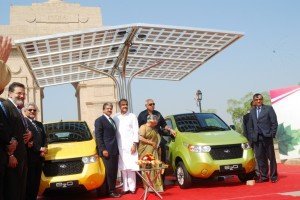India Launches A $15,000 Electric Car, With No Help From The Government

The Mahindra e2o (pronounced ee-two-oh) is a two-door, four-seater hatchback with snazzy styling and amenities that are rare in Indian cars, such as an automatic transmission and the ability to lock the car and work the A/C with a mobile app. It will inoculate its buyers from rising gas prices, provide relief from tailpipe exhaust on India’s polluted streets, and (if enough people buy it) stem India’s contribution of planet-warming greenhouse gases.
But drivers will also find that, outside of New Delhi, the car will cost more than $15,000, thousands of dollars more than comparable gas-powered vehicles that have more range and power. (Delhi has its own subsidy that drops the price to $11,003). The lithium-ion battery allows a range of 100 kilometers before recharge, and a top speed of 80 kilometers an hour — also significantly less than similar gas-powered hatchbacks. Drivers will be paying top dollar, without any of the government subsidies that are offered to electric-car buyers in the U.S., Europe or China.
“The Mahindra e2o is a near perfect amalgam of the dramatic advancements in automotive technology, electronics and information technology – a unique synthesis that we believe will help us shape and co-create, with our customers, the future of personal mobility solutions, as we know them,” said Chetan Maini, the founder of Reva, at the unveiling at New Delhi’s India Gate.
The event was also attended, ironically, by the government ministers of renewable energy and heavy industry, who have so far failed to deliver a subsidy that Mahindra considers crucial to the car’s fortunes. The government has lagged in its promise to create a $4.13 billion program to support electric transportation. Maini told me in January that he expected that plan to give a rebate of at least 150,000 rupees to each buyer of an e20. Since today’s announcements were silent on the subject, it appears that Mahindra decided to roll out the car despite its prohibitive, unsubsidized price.
The company announced the price as 596,000 rupees ($11,003), but that’s only the price in the capital city of New Delhi, which offers a 29 percent subsidy on the purchase of electric cars. Without that subsidy, other Indians will pay closer to 839,000 rupees ($15,489). The car will first be sold in the major cities of Delhi, Mumbai, Bangalore, Pune, Hyderabad, Chandigarh, Kochi and Ahmedabad.
That puts the car above the price range of comparable gas-powered hatchbacks in India, such as the the Maruti Suzuki Swift, which starts at 449,000 rupees ($8,289) and nearly double the price of economy models like the Maruti Alto, which starts at 321,000 rupees ($5,926). The price tag also means that Mahindra fell short of its goal of pegging the car at 15 to 20 percent above the sticker price of gas-powered cars, as articulated by Pawan Goenka, the president of Mahindra’s automotive and farm sector.
The e20 is a second act for electric car maker Reva, which for more than a decade struggled to win acceptance of its first offering, the REVAi. In 2010, as Reva was planning its new wheels, the company was purchased by the Indian industrial conglomerate Mahindra. Several months ago, Mahindra Reva debuted its new factory, which it expects to make 30,000 e2os a year within three years.
The e2o is a significant improvement in style over the utilitarian REVAi, but the first test drives are getting mixed reviews.
This tweet, made soon after the launch, seems to sum up both the promise and the problems of today’s subsidy-free launch of the e2o.
Related News


